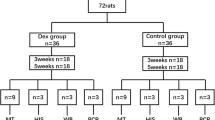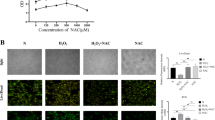Abstract
The Achilles tendon can support high tension forces and may experience lesions. The damaged tissue does not regenerate completely, with the organization and mechanical properties of the repaired tendon being inferior to those of a healthy tendon. Nitric oxide (NO) plays an important role in wound repair. We have examined the structural reorganization and repair in Achilles tendon after injury in rats treated with the NO synthase inhibitor L-NAME. The right Achilles tendon of male Wistar rats was partially transected. One group of rats was treated with L-NAME (~300 mg/kg per day, given in drinking water) for 4 days prior to tendon sectioning and throughout the post-operative period. Control rats received water without L-NAME. The tendons were excised at 7, 14, and 21 days post-injury and used to quantify hydroxyproline and for mechanical tests. Tendons were also processed for histomorphological analysis by polarized light microscopy, which showed that the collagen fibers were disorganized by day 7 in non-treated and L-NAME-treated rats. In non-treated rats, the organization of the extracellular matrix was more homogeneous by days 14 and 21 compared with day 7, although this homogeneity was less than that in normal tendon. In contrast, in injured tendons from L-NAME-treated rats, the collagen fibers were still disorganized on day 21. Tendons from treated rats had more hydroxyproline but lower mechanical properties compared with those from non-treated rats. Thus, NO modulates tendon healing, with a reduction in NO biosynthesis delaying reorganization of the extracellular matrix, especially collagen.




Similar content being viewed by others

References
Albina JE, Mills CD, Henry WL, Caldwell MD (1990) Temporal expression of different pathways of L-arginine metabolism in healing wounds. J Immunol 144:3877–3880
Arti S, Anamika MR, Ravi S (1999) Nitric oxide inhibits wound collagen synthesis. Mol Cell Biochem 200:27–33
Bulgrin JP, Shabani M, Chakravarthy D, Smith DJ (1995) Nitric oxide synthesis is suppressed in steroid-impaired and diabetic wounds. Wounds 7:48–57
Chakravortty D, Kumar KS (1997) Induction of cell proliferation and collagen synthesis in human small intestinal lamina propria fibroblasts by lipopolysaccharide: possible involvement of nitric oxide. Biochem Biophys Res Commun 240:458–463
Chatziantoniou C, Boffa JJ, Ardoillou R, Dussaule JC (1998) Nitric oxide inhibition induces early activation of type I collagen gene in renal resistance vessels and glomeruli in transgenic mice. Role of endothelin. J Clin Invest 101:2780–2789
Cribb M, Scott JE (1995) Tendon response to tensile stress: an ultrastructural investigation of collagen: proteoglycan interactions in stressed tendons. J Anat 187:423–428
Davis KL, Martin E, Turko IV, Murad F (2001) Novel effects of nitric oxide. Annu Rev Pharmacol Toxicol 41:203–236
Ezura Y, Chakravarti S, Oldberg A, Chervoneva I, Birk DE (2000) Diferential expression of lumican and fibromodulin regulate collagen fibrilogenesis in developing mouse tendons. J Cell Biol 151:779–787
Frank C, McDonald D, Wilson J, Eyre D, Shrive N (1995) Rabbit medial collateral ligament scar weakness is associated with decreased collagen pyridinoline crosslink density. J Orthop Res 13:157–165
Griffith OW, Stuehr DJ (1995) Nitric oxide synthases: properties and catalytic mechanism. Annu Rev Physiol 57:707–736
Hsu Y-C, Hsiao M, Wang L-F, Chien YW, Lee W-R (2006) Nitric oxide produced by iNOS is associated with collagen synthesis in keloid scar formation. Nitric Oxide 14:327–334
Lin J-H, Wang M-X, Wei A, Zhu W, Diwan AD, Murrell GAC (2001) Temporal expression of nitric oxide synthase isoforms in healing Achilles tendon. J Orthop Res 19:136–142
Lin TW, Cardena L, Soslowsky LJ (2004) Biomechanics of tendon injury and repair. J Biomech 37:865–877
Liu SH, Yang RS, al-Shaikh R, Lane JM (1995) Collagen in tendon, ligament, and bone healing. A current review. Clin Orthop Relat Res 318:265–278
Luo J, Chen AF (2005) Nitric oxide, a newly discovered function on wound healing. Acta Pharmacol Sin 26:256–264
Madden JW (1970) Current concepts of wound healing as applied to hand surgery. Orthop Clin North Am 1:325–334
Midwood KS, Williams LV, Schwarzbauer JE (2004) Tissue repair and the dynamics of the extracellular matrix. Int J Biochem Cell Biol 36:1031–1037
Moncada S, Higgs EA (1993) The L-arginine-nitric oxide pathway. N Engl J Med 329:2001–2012
Murrell GAC (2007a) Using nitric oxide to treat tendinopathy. Br J Sports Med 41:227–231
Murrell GAC (2007b) Oxygen free radicals and tendon healing. J Shoulder Elbow Surg 16:S208–S214
Murrell GAC, Szabo C, Hannafin JA, Jang D, Deng XH, Murrell DF, Warren RF (1997) Modulation of tendon healing by nitric oxide. Inflamm Res 46:19–27
Muscara NM, McKnight W, Asfaha S, Wallace JL (2000) Wound collagen deposition in rats: effects of an NO-NSAID and a selective COX-2 inhibitor. Br J Pharmacol 129:681–686
Nakagaki WR, Biancalana A, Benevides GP, Gomes L (2007) Biomechanical and biochemical properties of chicken calcaneal tendon under effect of age and nonforced active exercise. Connect Tissue Res 48:219–228
Owens MW, Milligan SA, Grisham MB (1996) Inhibition of pleural mesothelial cell collagen synthesis by nitric oxide. Free Radic Biol Med 21:601–607
Reddy GK, Stehno-Bittel L, Enwemeka CS (1999) Matrix remodeling in healing rabbit Achilles tendon. Wound Repair Regen 7:518–527
Rizk M, Witte MB, Barbul A (2004) Nitric oxide and wound healing. World J Surg 28:301–306
Schäffer MR, Tantry U, Gross SS, Wasserburg HL, Barbul A (1996) Nitric oxide regulates wound healing. J Surg Res 63:237–240
Schäffer MR, Efron PA, Thornton FJ, Klingel K, Gross SS, Barbul A (1997) Nitric oxide, an autocrine regulator of wound fibroblast synthetic function. J Immunol 158:2375–2381
Schäffer MR, Tantry U, Thornton FJ, Barbul A (1999) Inhibition of nitric oxide synthesis in wounds: pharmacology and effect on accumulation of collagen in wounds in mice. Eur J Surg 165:262–267
Sharma P, Maffulli N (2005) Tendon injury and tendinopathy: healing and repair. J Bone Joint Surg 87:187–202
Sharma P, Maffulli N (2006) Biology of tendon injury: healing, modeling and remodeling. J Musculoskelet Neuronal Interact 6:181–190
Shi HP, Efron DT, Most D, Tantry US, Barbul A (2000) Supplemental dietary arginine enhances wound healing in normal but not inducible nitric oxide synthase knockout mice. Surgery 128:374–378
Shi HP, Efron DT, Most D, Barbul A (2001) The role of iNOS in wound healing. Surgery 130:225–229
Shukla A, Rasik AM, Shankar R (1999) Nitric oxide inhibits wound collagen synthesis. Mol Cell Biochem 200:27–33
Silva MJ, Ritty TM, Ditsios K, Burns ME, Boyer MI, Gelberman RH (2007) Tendon injury response: assessment of biomechanical properties, tissue morphology and viability following flexor digitorum profundus tendon transection. J Orthop Res 22:990–997
Sparrow KJ, Finucane SD, Owen JR, Wayne JS (2005) The effects of low-intensity ultrasound on medial collateral ligament in the rabbit model. Am J Sports Med 33:1048–1056
Stegeman H, Stalder K (1967) Determination of hydroxyproline. Clin Chim Acta 18:267–273
Thornton FJ, Schäffer MR, Witte MB, Moldawer LL, MacKay SL, Abouhamze A, Tannahill CL, Barbul A (1998) Enhanced collagen accumulation following direct transfection of the inducible nitric oxide synthase gene in cutaneous wounds. Biochem Biophys Res Commun 246:654–659
Vidal BC (1995) Crimp as part of helical structure. C R Acad Sci III 318:173–178
Viidik A (1978) On the correlation between structure and mechanical function of soft connective tissues. Verh Anat Ges 72:75–89
Vilarta R, Vidal BC (1989) Anisotropic and biomechanical properties of tendons modified by exercise and denervation: aggregation and macromolecular order in collagen bundles. Matrix 9:55–61
Witte MB, Barbul A (2002) Role of nitric oxide in wound repair. Am J Surg 4:406–412
Woo SL, Hildebrand K, Watanabe N, Fenwick JA, Papageorgiou CD, Wang JH (1999a) Tissue engineering of ligament and tendon healing. Clin Orthop Relat Res 367:S312–S323
Woo SLY, Debski RE, Withrow JD, Janaushek MA (1999b) Biomechanics of knee ligaments. Am J Sports Med 27:533–543
Xia W, Szomor Z, Wang Y, Murrell GAC (2006a) Nitric oxide enhances collagen synthesis in cultured human tendon cells. J Orthop Res 24:159–172
Xia W, Wang Y, Appleyard RC, Smythe GA, Murrell GAC (2006b) Spontaneous recovery of injured Achilles tendon in inducible nitric oxide synthase gene knockout mice. Inflamm Res 55:40–45
Acknowledgments
The authors thank Francisco Angelo Malatesta for technical assistance.
Author information
Authors and Affiliations
Corresponding author
Additional information
T.C.T. and W.R.N were supported by studentships from CAPES, and S.H. was supported by a research fellowship from Conselho Nacional de Desenvolvimento Científico e Tecnológico (CNPq).
Rights and permissions
About this article
Cite this article
Tomiosso, T.C., Nakagaki, W.R., Gomes, L. et al. Organization of collagen bundles during tendon healing in rats treated with L-NAME. Cell Tissue Res 337, 235–242 (2009). https://doi.org/10.1007/s00441-009-0819-5
Received:
Accepted:
Published:
Issue Date:
DOI: https://doi.org/10.1007/s00441-009-0819-5



